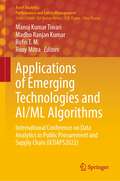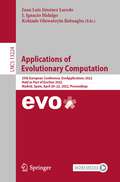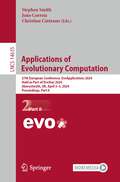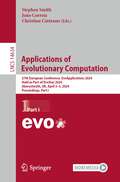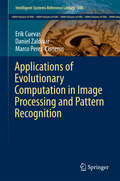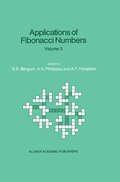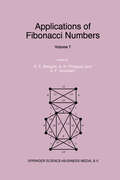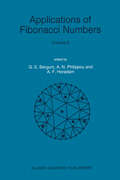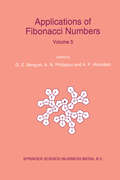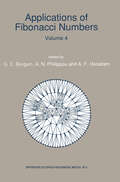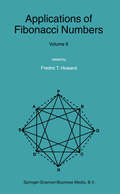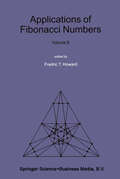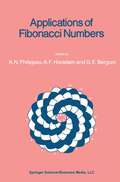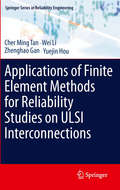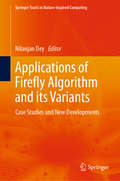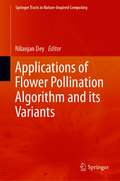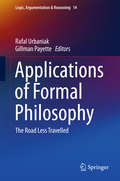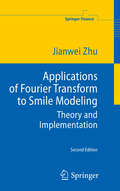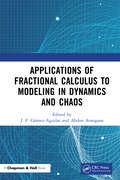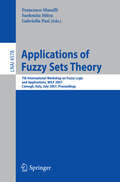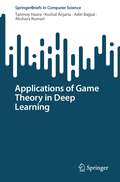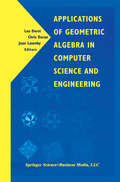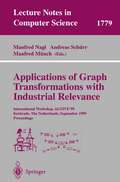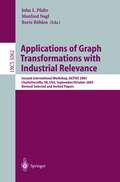- Table View
- List View
Applications of Emerging Technologies and AI/ML Algorithms: International Conference on Data Analytics in Public Procurement and Supply Chain (ICDAPS2022) (Asset Analytics)
by Manoj Kumar Tiwari Madhu Ranjan Kumar Rofin T. M. Rony MitraThis book provides practical insights into applications of the state-of-the-art of Machine Learning and Artificial Intelligence (AI) for solving intriguing and complex problems in procurement and supply chain management. The application domain includes perishable food supply chain, steel price prediction, electric vehicle charging infrastructure design, contract price negotiation, reverse logistics network design, and demand forecasting. Further, the book highlights the advanced topics in the procurement field, like AI in green procurement and e-procurement in the pharma sector. Furthermore, the book covers applications of well-established methodologies such as heuristics, optimization, game theory, and MCDM based on the nature of the problem. The inclusion of the vaccine supply chain digital twin and blockchain-based procurement signals the significance of the book. This book is a comprehensive guide for industry professionals to understand the power of data analytics, enabling them to improve efficiency and effectiveness in the procurement and supply chain sectors.
Applications of Evolutionary Computation: 25th European Conference, EvoApplications 2022, Held as Part of EvoStar 2022, Madrid, Spain, April 20–22, 2022, Proceedings (Lecture Notes in Computer Science #13224)
by Juan Luis Jiménez Laredo J. Ignacio Hidalgo Kehinde Oluwatoyin BabaagbaThis book constitutes the refereed proceedings of the 25th International Conference on Applications of Evolutionary Computation, EvoApplications 2022, held as part of Evo*2022, in April 2022, co-located with the Evo*2022 events EuroGP, EvoCOP, and EvoMUSART. The 46 revised full papers presented in this book were carefully reviewed and selected from 67 submissions.
Applications of Evolutionary Computation: 27th European Conference, EvoApplications 2024, Held as Part of EvoStar 2024, Aberystwyth, UK, April 3–5, 2024, Proceedings, Part II (Lecture Notes in Computer Science #14635)
by Stephen Smith João Correia Christian CintranoThe two-volume set LNCS 14634 and 14635 constitutes the refereed proceedings of the 27th European Conference on Applications of Evolutionary Computation, EvoApplications 2024, held as part of EvoStar 2024, in Aberystwyth, UK, April 3–5, 2024, and co-located with the EvoStar events, EvoCOP, EvoMUSART, and EuroGP.The 51 full papers presented in these proceedings were carefully reviewed and selected from 77 submissions. The papers have been organized in the following topical sections: applications of evolutionary computation; analysis of evolutionary computation methods: theory, empirics, and real-world applications; computational intelligence for sustainability; evolutionary computation in edge, fog, and cloud computing; evolutionary computation in image analysis, signal processing and pattern recognition; evolutionary machine learning; machine learning and AI in digital healthcare and personalized medicine; problem landscape analysis for efficient optimization; softcomputing applied to games; and surrogate-assisted evolutionary optimisation.
Applications of Evolutionary Computation: 27th European Conference, EvoApplications 2024, Held as Part of EvoStar 2024, Aberystwyth, UK, April 3–5, 2024, Proceedings, Part I (Lecture Notes in Computer Science #14634)
by Stephen Smith João Correia Christian CintranoThe two-volume set LNCS 14634 and 14635 constitutes the refereed proceedings of the 27th European Conference on Applications of Evolutionary Computation, EvoApplications 2024, held as part of EvoStar 2024, in Aberystwyth, UK, April 3–5, 2024, and co-located with the EvoStar events, EvoCOP, EvoMUSART, and EuroGP.The 51 full papers presented in these proceedings were carefully reviewed and selected from 77 submissions. The papers have been organized in the following topical sections: applications of evolutionary computation; analysis of evolutionary computation methods: theory, empirics, and real-world applications; computational intelligence for sustainability; evolutionary computation in edge, fog, and cloud computing; evolutionary computation in image analysis, signal processing and pattern recognition; evolutionary machine learning; machine learning and AI in digital healthcare and personalized medicine; problem landscape analysis for efficient optimization; softcomputing applied to games; and surrogate-assisted evolutionary optimisation.
Applications of Evolutionary Computation in Image Processing and Pattern Recognition (Intelligent Systems Reference Library #100)
by Erik Cuevas Daniel Zaldívar Marco Perez-CisnerosThis book presents the use of efficient Evolutionary Computation (EC) algorithms for solving diverse real-world image processing and pattern recognition problems. It provides an overview of the different aspects of evolutionary methods in order to enable the reader in reaching a global understanding of the field and, in conducting studies on specific evolutionary techniques that are related to applications in image processing and pattern recognition. It explains the basic ideas of the proposed applications in a way that can also be understood by readers outside of the field. Image processing and pattern recognition practitioners who are not evolutionary computation researchers will appreciate the discussed techniques beyond simple theoretical tools since they have been adapted to solve significant problems that commonly arise on such areas. On the other hand, members of the evolutionary computation community can learn the way in which image processing and pattern recognition problems can be translated into an optimization task. The book has been structured so that each chapter can be read independently from the others. It can serve as reference book for students and researchers with basic knowledge in image processing and EC methods.
Applications of Fibonacci Numbers: Volume 3 Proceedings of ‘The Third International Conference on Fibonacci Numbers and Their Applications’, Pisa, Italy, July 25–29, 1988
by G. E. Bergum Andreas N. Philippou Alwyn F. HoradamThis book contains thirty-six papers from among the forty-five papers presented at the Third International Conference on Fibonacci Numbers and Their Applications which was held in Pisa, Italy from July 25 to July 29, 1988 in honor of Leonardo de Pisa. These papers have been selected after a careful review by well known referees in the field, and they range from elementary number theory to probability and statistics. The Fibonacci numbers are their unifying bond. It is anticipated that this book, like its two predecessors, will be useful to research workers and graduate students interested in the Fibonacci numbers and their applications. August 1989 The Editors Gerald E. Bergum South Dakota State University Brookings, South Dakota, U. S. A. Andreas N. Philippou Ministry of Education Nicosia, Cyprus Alwyn F. Horadam University of New England Armidale N. S. W. , Australia xv THE ORGANIZING COMMITTEES LOCAL COMMITTEE INTERNATIONAL COMMITTEE Dvornicich, Roberto, Chairman Horadam, A. F. (Australia), Co-chairman Filipponi, Piero Philippou, A. N. (Cyprus), Co-chairman Perelli, Alberto Ando, S. (Japan) Viola, Carlo Bergum, G. E. (U. S. A. ) Zannier, Umberto Johnson, M. B. (U. S. A. ) Kiss, P. (Hungary) Tijdeman, Robert (The Netherlands) Tognetti, K. (Australia) XVII LIST OF CONTRIBUTORS TO THE CONFERENCE' ADLER, I. , RR 1, Box 532, North Bennington, VT 05257-9748. "Separating the Biological from the Mathematical Aspects of Phyllotaxis. " *AKRITAS, A. G. , (coauthor P. G. Bradford). "The Role of the Fibonacci Sequence in the Isolation of the Real Roots of Polynomial Equations.
Applications of Fibonacci Numbers: Volume 7
by G. E. Bergum Andreas N. Philippou Alwyn F. HoradamProceedings of `The Seventh International Research Conference on Fibonacci Numbers and Their Applications', Technische Universität, Graz, Austria, July 15-19, 1996
Applications of Fibonacci Numbers: Volume 6 Proceedings of ‘The Sixth International Research Conference on Fibonacci Numbers and Their Applications’, Washington State University, Pullman, Washington, U.S.A., July 18-22, 1994
by G. E. Bergum Andreas N. Philippou Alwyn F. HoradamThis book contains 43 papers form among the 55 papers presented at the Sixth International Conference on Fibonacci Numbers and Their Applications which was held at Washington State University, Pullman, Washington, from July 18-22, 1994. These papers have been selected after a careful review by well known referees in the field, and they range from elementary number theory to probability and statistics. The Fibonacci numbers and recurrence relations are their unifying bond. It is anticipated that this book, like its five predecessors, will be useful to research workers and graduate students interested in the Fibonacci numbers and their applications. October 30, 1995 The Editors Gerald E. Bergum South Dakota State University Brookings, South Dakota, U.S.A. Alwyn F. Horadam University of New England Armidale, N.S.W., Australia Andreas N. Philippou 26 Atlantis Street Aglangia, Nicosia Cyprus xxi THE ORGANIZING COMMITTEES LOCAL COMMITTEE INTERNATIONAL COMMITTEE Long, Calvin T., Co-Chair Horadam, A.F. (Australia), Co-Chair Webb, William A., Co-Chair Philippou, A.N. (Cyprus), Co-Chair Burke, John Ando, S. (Japan) DeTemple, Duane W.
Applications of Fibonacci Numbers: Proceedings of ‘The Fifth International Conference on Fibonacci Numbers and Their Applications’, The University of St. Andrews, Scotland, July 20—July 24, 1992
by G. E. Bergum Andreas N. Philippou Alwyn F. HoradamThis book contains 58 papers from among the 68 papers presented at the Fifth International Conference on Fibonacci Numbers and Their Applications which was held at the University of St. Andrews, St. Andrews, Fife, Scotland from July 20 to July 24, 1992. These papers have been selected after a careful review by well known referees in the field, and they range from elementary number theory to probability and statistics. The Fibonacci numbers and recurrence relations are their unifying bond. It is anticipated that this book, like its four predecessors, will be useful to research workers and graduate students interested in the Fibonacci numbers and their applications. June 5, 1993 The Editors Gerald E. Bergum South Dakota State University Brookings, South Dakota, U.S.A. Alwyn F. Horadam University of New England Armidale, N.S.W., Australia Andreas N. Philippou Government House Z50 Nicosia, Cyprus xxv THE ORGANIZING COMMITTEES LOCAL COMMITTEE INTERNATIONAL COMMITTEE Campbell, Colin M., Co-Chair Horadam, A.F. (Australia), Co-Chair Phillips, George M., Co-Chair Philippou, A.N. (Cyprus), Co-Chair Foster, Dorothy M.E. Ando, S. (Japan) McCabe, John H. Bergum, G.E. (U.S.A.) Filipponi, P. (Italy) O'Connor, John J.
Applications of Fibonacci Numbers: Volume 4 Proceedings of ‘The Fourth International Conference on Fibonacci Numbers and Their Applications’, Wake Forest University, N.C., U.S.A., July 30–August 3, 1990
by G. E. Bergum Andreas N. Philippou Alwyn F. HoradamThis book contains thirty-three papers from among the thirty-eight papers presented at the Fourth International Conference on Fibonacci Numbers and Their Applications which was held at Wake Forest University, Winston-Salem, North Carolina from July 30 to August 3, 1990. These papers have been selected after a careful review by well known referees in the field, and they range from elementary number theory to probability and statistics. The Fibonacci numbers and recurrence relations are their unifying bond. It is anticipated that this book, like its three predecessors, will be useful to research workers and graduate students interested in the Fibonacci numbers and their applications. March 1, 1991 The Editors Gerald E. Bergum South Dakota State University Brookings, South Dakota, U. S. A. Alwyn F. Horadam University of New England Armidale, N. S. W. , Australia Andreas N. Philippou Minister of Education Ministry of Education Nicosia, Cyprus xv THE ORGANIZING COMMITTEES LOCAL COMMITTEE INTERNATIONAL COMMITTEE Howard, Fred T. , Co-Chair Horadam, A. F. (Australia), Co-Chair Waddill, Marcellus E. , Co-Chair Philippou, A. N. (Cyprus), Co-Chair Hayashi, Elmer K. Ando, S. (Japan) Bergum, G. E. (U. S. A. ) Vaughan, Theresa Harrell, Deborah Bicknell-Johnson, M. B. (U. S. A. ) Campbell, Colin (Scotland) Filipponi, Piero (Italy) Kiss, P. (Hungary) Turner, J. C. (New Zealand) xvii LIST OF CONTRIBUTORS TO THE CONFERENCE *ALFORD, CECIL 0. , (coauthor Daniel C. Fielder) "Pascal's Triangle: Top Gun or Just One of the Gang?" *ANDERSON, PETER G. , "A Fibonacci-Based Pseudo-Random Number Generator.
Applications of Fibonacci Numbers: Volume 9: Proceedings of The Tenth International Research Conference on Fibonacci Numbers and Their Applications
by Fredric T. HowardThis book contains 28 research articles from among the 49 papers and abstracts presented at the Tenth International Conference on Fibonacci Numbers and Their Applications. These articles have been selected after a careful review by expert referees, and they range over many areas of mathematics. The Fibonacci numbers and recurrence relations are their unifying bond. We note that the article "Fibonacci, Vern and Dan" , which follows the Introduction to this volume, is not a research paper. It is a personal reminiscence by Marjorie Bicknell-Johnson, a longtime member of the Fibonacci Association. The editor believes it will be of interest to all readers. It is anticipated that this book, like the eight predecessors, will be useful to research workers and students at all levels who are interested in the Fibonacci numbers and their applications. March 16, 2003 The Editor Fredric T. Howard Mathematics Department Wake Forest University Box 7388 Reynolda Station Winston-Salem, NC 27109 xxi THE ORGANIZING COMMITTEES LOCAL COMMITTEE INTERNATIONAL COMMITTEE Calvin Long, Chairman A. F. Horadam (Australia), Co-Chair Terry Crites A. N. Philippou (Cyprus), Co-Chair Steven Wilson A. Adelberg (U. S. A. ) C. Cooper (U. S. A. ) Jeff Rushal H. Harborth (Germany) Y. Horibe (Japan) M. Bicknell-Johnson (U. S. A. ) P. Kiss (Hungary) J. Lahr (Luxembourg) G. M. Phillips (Scotland) J. 'Thrner (New Zealand) xxiii xxiv LIST OF CONTRlBUTORS TO THE CONFERENCE * ADELBERG, ARNOLD, "Universal Bernoulli Polynomials and p-adic Congruences. " *AGRATINI, OCTAVIAN, "A Generalization of Durrmeyer-Type Polynomials. " BENJAMIN, ART, "Mathemagics.
Applications of Fibonacci Numbers: Volume 8: Proceedings of The Eighth International Research Conference on Fibonacci Numbers and Their Applications
by Fredric T. HowardThis book contains 33 papers from among the 41 papers presented at the Eighth International Conference on Fibonacci Numbers and Their Applications which was held at the Rochester Institute of Technology, Rochester, New York, from June 22 to June 26, 1998. These papers have been selected after a careful review by well known referees in the field, and they range from elementary number theory to probability and statistics. The Fibonacci numbers and recurrence relations are their unifying bond. It is anticipated that this book, like its seven predecessors, will be useful to research workers and graduate students interested in the Fibonacci numbers and their applications. June 1, 1999 The Editor F. T. Howard Mathematics and Computer Science Wake Forest University Box 7388 Reynolda Station Winston-Salem, NC USA xvii THE ORGANIZING COMMITTEES LOCAL COMMITTEE INTERNATIONAL COMMITTEE Anderson, Peter G. , Chairman Horadam, A. F. (Australia), Co-Chair Arpaya, Pasqual Philippou, A. N. (Cyprus), Co-Chair Biles, John Bergum, G. E. (U. S. A. ) Orr, Richard Filipponi, P. (Italy) Radziszowski, Stanislaw Harborth, H. (Germany) Rich, Nelson Horibe, Y. (Japan) Howard, F. (U. S. A. ) Johnson, M. (U. S. A. ) Kiss, P. (Hungary) Phillips, G. M. (Scotland) Turner, J. (New Zealand) Waddill, M. E. (U. S. A. ) xix LIST OF CONTRIBUTORS TO THE CONFERENCE AGRATINI, OCTAVIAN, "Unusual Equations in Study. " *ANDO, SHIRO, (coauthor Daihachiro Sato), "On the Generalized Binomial Coefficients Defined by Strong Divisibility Sequences. " *ANATASSOVA, VASSIA K. , (coauthor J. C.
Applications of Fibonacci Numbers: Volume 2
by Andreas N. Philippou Alwyn F. Horadam G. E. BergumThis book contains nineteen papers from among the twenty-five papers presented at the Second International Conference on Fibonacci Numbers and Their Applications. These papers have been selected after a careful review by well known referee's in the field, and they range from elementary number theory to probability and statistics. The Fibonacci numbers are their unifying bond. It is anticipated that this book will be useful to research workers and graduate students interested in the Fibonacci numbers and their applications. October 1987 The Editors Gerald E. Bergum South Dakota State University Brookings, South Dakota, U.S.A. Andreas N. Philippou University of Patras Patras, Greece Alwyn F. Horadam University of New England Armidale, N.S.W., Australia xiii THE ORGANIZING COMMITTEES LOCAL COMMITTEE INTERN A TIONAL COMMITTEE Bergum, G., Chairman Philippou, A. (Greece), Chairman Edgar, H., Co-chalrman Horadam, A. (Australia), Co-chalrman Bergum, G. (U.s.A.) Thoro, D. Kiss, P. (Hungary) Johnson, M. Long, C. (U.S.A.) Lange, L.
Applications of Finite Element Methods for Reliability Studies on ULSI Interconnections (Springer Series in Reliability Engineering)
by Cher Ming Tan Wei Li Zhenghao Gan Yuejin HouApplications of Finite Element Methods for Reliability Studies on ULSI Interconnections provides a detailed description of the application of finite element methods (FEMs) to the study of ULSI interconnect reliability. Over the past two decades the application of FEMs has become widespread and continues to lead to a much better understanding of reliability physics.To help readers cope with the increasing sophistication of FEMs’ applications to interconnect reliability, Applications of Finite Element Methods for Reliability Studies on ULSI Interconnections will:introduce the principle of FEMs;review numerical modeling of ULSI interconnect reliability;describe the physical mechanism of ULSI interconnect reliability encountered in the electronics industry; anddiscuss in detail the use of FEMs to understand and improve ULSI interconnect reliability from both the physical and practical perspective, incorporating the Monte Carlo method.A full-scale review of the numerical modeling methodology used in the study of interconnect reliability highlights useful and noteworthy techniques that have been developed recently. Many illustrations are used throughout the book to improve the reader’s understanding of the methodology and its verification. Actual experimental results and micrographs on ULSI interconnects are also included.Applications of Finite Element Methods for Reliability Studies on ULSI Interconnections is a good reference for researchers who are working on interconnect reliability modeling, as well as for those who want to know more about FEMs for reliability applications. It gives readers a thorough understanding of the applications of FEM to reliability modeling and an appreciation of the strengths and weaknesses of various numerical models for interconnect reliability.
Applications of Firefly Algorithm and its Variants: Case Studies and New Developments (Springer Tracts in Nature-Inspired Computing)
by Nilanjan DeyThe book discusses advantages of the firefly algorithm over other well-known metaheuristic algorithms in various engineering studies. The book provides a brief outline of various application-oriented problem solving methods, like economic emission load dispatch problem, designing a fully digital controlled reconfigurable switched beam nonconcentric ring array antenna, image segmentation, span minimization in permutation flow shop scheduling, multi-objective load dispatch problems, image compression, etc., using FA and its variants. It also covers the use of the firefly algorithm to select features, as research has shown that the firefly algorithm generates precise and optimal results in terms of time and optimality. In addition, the book also explores the potential of the firefly algorithm to provide a solution to traveling salesman problem, graph coloring problem, etc
Applications of Flower Pollination Algorithm and its Variants (Springer Tracts in Nature-Inspired Computing)
by Nilanjan DeyThis book presents essential concepts of traditional Flower Pollination Algorithm (FPA) and its recent variants and also its application to find optimal solution for a variety of real-world engineering and medical problems. Swarm intelligence-based meta-heuristic algorithms are extensively implemented to solve a variety of real-world optimization problems due to its adaptability and robustness. FPA is one of the most successful swarm intelligence procedures developed in 2012 and extensively used in various optimization tasks for more than a decade. The mathematical model of FPA is quite straightforward and easy to understand and enhance, compared to other swarm approaches. Hence, FPA has attracted attention of researchers, who are working to find the optimal solutions in variety of domains, such as N-dimensional numerical optimization, constrained/unconstrained optimization, and linear/nonlinear optimization problems. Along with the traditional bat algorithm, the enhanced versions of FPA are also considered to solve a variety of optimization problems in science, engineering, and medical applications.
Applications of Formal Philosophy: The Road Less Travelled (Logic, Argumentation & Reasoning #14)
by Rafał Urbaniak Gillman PayetteThis book features mathematical and formal philosophers’ efforts to understand philosophical questions using mathematical techniques. It offers a collection of works from leading researchers in the area, who discuss some of the most fascinating ways formal methods are now being applied. It covers topics such as: the uses of probable and statistical reasoning, rational choice theory, reasoning in the environmental sciences, reasoning about laws and changes of rules, and reasoning about collective decision procedures as well as about action. Utilizing mathematical techniques has been very fruitful in the traditional domains of formal philosophy – logic, philosophy of mathematics and metaphysics – while formal philosophy is simultaneously branching out into other areas in philosophy and the social sciences. These areas particularly include ethics, political science, and the methodology of the natural and social sciences. Reasoning about legal rules, collective decision-making procedures, and rational choices are of interest to all those engaged in legal theory, political science and economics. Statistical reasoning is also of interest to political scientists and economists.
Applications of Fourier Transform to Smile Modeling: Theory and Implementation (Springer Finance)
by Jianwei ZhuThis book addresses the applications of Fourier transform to smile modeling. Smile effect is used generically by ?nancial engineers and risk managers to refer to the inconsistences of quoted implied volatilities in ?nancial markets, or more mat- matically, to the leptokurtic distributions of ?nancial assets and indices. Therefore, a sound modeling of smile effect is the central challenge in quantitative ?nance. Since more than one decade, Fourier transform has triggered a technical revolution in option pricing theory. Almost all new developed option pricing models, es- cially in connection with stochastic volatility and random jump, have extensively applied Fourier transform and the corresponding inverse transform to express - tion pricing formulas. The large accommodation of the Fourier transform allows for a very convenient modeling with a general class of stochastic processes and d- tributions. This book is then intended to present a comprehensive treatment of the Fourier transform in the option valuation, covering the most stochastic factors such as stochastic volatilities and interest rates, Poisson and Levy ´ jumps, including some asset classes such as equity, FX and interest rates, and providing numerical ex- ples and prototype programming codes. I hope that readers will bene?t from this book not only by gaining an overview of the advanced theory and the vast large l- erature on these topics, but also by gaining a ?rst-hand feedback from the practice on the applications and implementations of the theory.
Applications of Fractional Calculus to Modeling in Dynamics and Chaos
by Gómez-Aguilar, J. F. Abdon AtanganaApplications of Fractional Calculus to Modeling in Dynamics and Chaos aims to present novel developments, trends, and applications of fractional-order derivatives with power law and Mittag-Leffler kernel in the areas of chemistry, mechanics, chaos, epidemiology, fluid mechanics, modeling, and engineering. Non-singular and non-local fractional-order derivatives have been applied in different chapters to describe complex problems. The book offers theory and practical applications for the solutions of real-life problems and will be of interest to graduate-level students, educators, researchers, and scientists interested in mathematical modeling and its diverse applications. Features Discusses real-world problems, theory, and applications Covers new developments and advances in the various areas of nonlinear dynamics, signal processing, and chaos Suitable to teach master’s and/or PhD-level graduate students, and can be used by researchers, from any field of the social, health, and physical sciences
Applications of Fractional Calculus to Modeling in Dynamics and Chaos
by J. F. Gómez-Aguilar Abdon AtanganaApplications of Fractional Calculus to Modeling in Dynamics and Chaos aims to present novel developments, trends, and applications of fractional-order derivatives with power law and Mittag-Leffler kernel in the areas of chemistry, mechanics, chaos, epidemiology, fluid mechanics, modeling, and engineering. Non-singular and non-local fractional-order derivatives have been applied in different chapters to describe complex problems. The book offers theory and practical applications for the solutions of real-life problems and will be of interest to graduate-level students, educators, researchers, and scientists interested in mathematical modeling and its diverse applications. Features Discusses real-world problems, theory, and applications Covers new developments and advances in the various areas of nonlinear dynamics, signal processing, and chaos Suitable to teach master’s and/or PhD-level graduate students, and can be used by researchers, from any field of the social, health, and physical sciences
Applications of Fuzzy Sets Theory: 7th International Workshop on Fuzzy Logic and Applications, WILF 2007, Camogli, Italy, July 7-10, 2007, Proceedings (Lecture Notes in Computer Science #4578)
by Francesco Masulli Sushmita Mitra Gabriella PasiThe 7th International Workshop on Fuzzy Logic and Applications, held in Camogli, Italy in July 2007, presented the latest findings in the field. This volume features the refereed proceedings from that meeting. It includes 84 full papers as well as three keynote speeches. The papers are organized into topical sections covering fuzzy set theory, fuzzy information access and retrieval, fuzzy machine learning, and fuzzy architectures and systems.
Applications of Game Theory in Deep Learning (SpringerBriefs in Computer Science)
by Tanmoy Hazra Kushal Anjaria Aditi Bajpai Akshara KumariThis book aims to unravel the complex tapestry that interweaves strategic decision-making models with the forefront of deep learning techniques. Applications of Game Theory in Deep Learning provides an extensive and insightful exploration of game theory in deep learning, diving deep into both the theoretical foundations and the real-world applications that showcase this intriguing intersection of fields. Starting with the essential foundations for comprehending both game theory and deep learning, delving into the individual significance of each field, the book culminates in a nuanced examination of Game Theory's pivotal role in augmenting and shaping the development of Deep Learning algorithms. By elucidating the theoretical underpinnings and practical applications of this synergistic relationship, we equip the reader with a comprehensive understanding of their combined potential. In our digital age, where algorithms and autonomous agents are becoming more common, the combination of game theory and deep learning has opened a new frontier of exploration. The combination of these two disciplines opens new and exciting avenues. We observe how artificial agents can think strategically, adapt to ever-shifting environments, and make decisions that are consistent with their goals and the dynamics of their surroundings. This book presents case studies, methodologies, and real-world applications.
Applications of Geometric Algebra in Computer Science and Engineering
by Leo Dorst Chris Doran Joan LasenbyGeometric algebra has established itself as a powerful and valuable mathematical tool for solving problems in computer science, engineering, physics, and mathematics. The articles in this volume, written by experts in various fields, reflect an interdisciplinary approach to the subject, and highlight a range of techniques and applications. Relevant ideas are introduced in a self-contained manner and only a knowledge of linear algebra and calculus is assumed. Features and Topics: * The mathematical foundations of geometric algebra are explored * Applications in computational geometry include models of reflection and ray-tracing and a new and concise characterization of the crystallographic groups * Applications in engineering include robotics, image geometry, control-pose estimation, inverse kinematics and dynamics, control and visual navigation * Applications in physics include rigid-body dynamics, elasticity, and electromagnetism * Chapters dedicated to quantum information theory dealing with multi- particle entanglement, MRI, and relativistic generalizations Practitioners, professionals, and researchers working in computer science, engineering, physics, and mathematics will find a wide range of useful applications in this state-of-the-art survey and reference book. Additionally, advanced graduate students interested in geometric algebra will find the most current applications and methods discussed.
Applications of Graph Transformations with Industrial Relevance: International Workshop, AGTIVE'99 Kerkrade, The Netherlands, September 1-3, 1999 Proceedings (Lecture Notes in Computer Science #1779)
by Manfred Nagl Andreas Schürr Manfred MünchThis book constitutes the thoroughly refereed post-proceedings of the International Workshop on Graph Transformation with Industrial Relevance, AGTIVE'99, held in Kerkrade, The Netherlands, in June 1999.The 28 revised full papers presented went through an iterated process of reviewing and revision. Also included are three invited papers, 10 tool demonstrations, a summary of a panel discussion, and lists of graph transformation systems and books on graph transformations. The papers are organized in sections on modularization concepts, distributed systems modeling, software architecture: evolution and reengineering, visual graph transformation languages, visual language modeling and tool development, knowledge modeling, image recognition and constraint solving, process modeling and view integration, and visualization and animation tools.
